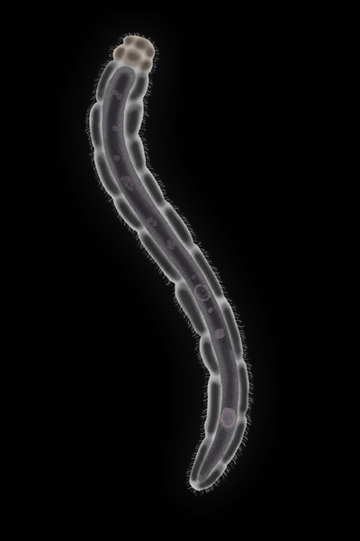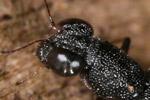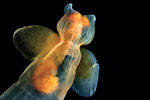The range of habitats that animals have come to occupy is nothing short of staggering. Take the dicyemids for example. They are among the simplest animals on the planet, with a tiny, worm-like adult body that consists of between 10 and 40 cells. They have no organs, body cavities or even guts—a structural simplicity which is a consequence of where and how they live. The only place you will find adult dicyemids is inside the bodies of cephalopods, typically octopuses and cuttlefish where large numbers of them cling to the inner wall of the mollusc’s kidney.
Now, as habitats go, this is pretty weird and you are probably thinking that these tiny, very simple animals must be parasites. But this is where it gets really odd because it seems dicyemids actually benefit their host by helping it get rid of harmful metabolic waste products as well as improving the flow of urine through the kidney.
 Illustration showing an adult dicyemid. Within the long, central cell new individuals are forming. At the anterior end (top) is the calotte—a specialized group of cells for clinging to the inner wall of the host’s kidney. Photo by: ©Phil Miller. |
This incredible relationship illustrates two very interesting points. Firstly, parasitism can be part of a spectrum of interactions with commensalism and mutualism at each extreme. The dicyemids’ ancestors, very likely annelid-like creatures, probably started living with and then taking advantage of cephalopods. But over huge stretches of time, what was once a parasitic relationship has become a mutualistic one with both parties benefitting.
Secondly, the extreme simplicity of the dicyemid body-plan demonstrates that evolution is not just a one-way process where simple forms give rise to more complex forms. In adapting to a specific niche an animal can degenerate, losing many of the structural complexities of its ancestors if they are surplus to requirements. The dicyemids’ free-living ancestor would have had a fully-formed gut, but in a habitat where you are bathed in food and all of your nourishment can simply be absorbed through your skin there is no need for a specialized gut and it has been progressively lost. Similarly, surrounded by food and others of your kind and safely ensconced in the body of a larger animal what use are senses and a central nervous system?
The dicyemids, as small and as seemingly insignificant as they are, teach us a great deal about what it is to be an animal and the dynamic processes that continue to shape the natural world.

An adult dicyemid. These extremely simple animals live inside the kidneys of cephalopods, typically octopuses and cuttlefish. It seems as though their relationship with the host may have extended beyond parasitism to become a mutualism. Photo: © Hidetaka Furuya.
Dr. Ross Piper is a zoologist and author and has recently presented on the BBC/Smithsonian TV production, Wild Burma: Nature’s Lost Kingdom, soon to be shown in the USA. You can read an interview with Ross Piper here: Animal Earth: exploring the hidden biodiversity of our planet.
 |
Further reading:
- Suzuki TG, et al. Phylogenetic analysis of dicyemid mesozoans (phylum Dicyemida) from innexin amino acid sequences: dicyemids are not related to Platyhelminthes. J Parasitol. 2010;96(3):614-25.
- Piper R. Animal Earth: The Amazing Diversity of Living Creatures. Thames and Hudson, London, 2013.
Related articles
Wonderful Creatures: A nematode drama played out in a millipede’s gut

(01/17/2014) Nematodes are typically small animals that to the naked eye look very much alike; however, these creatures are fantastically diverse —on a par with the arthropods in terms of species diversity. At face value, nematodes lack the charisma of larger animals, so there are very few biologists who have made it their life’s work to understand them. Those who do have been rewarded with a glimpse of the incredible diversity of these animals, an example of which is the complex menagerie of nematodes that dwell in the guts of large, tropical millipedes.
Wonderful Creatures: the lightning-fast Stenus beetles

(01/10/2014) Rove beetles are among the most diverse animals on the planet, with around 56,000 species currently described. Amongst this multitude of species is a dazzling array of adaptations perhaps best illustrated by the genus Stenus. These beetles, with their bulbous eyes and slender bodies are often found near water running swiftly over the wet ground and clambering among the vegetation.
Animal Earth: exploring the hidden biodiversity of our planet

(12/03/2013) Most of the species on Earth we never see. In fact, we have no idea what they look like, much less how spectacular they are. In general, people can identify relatively few of their backyard species, much less those of other continents. This disconnect likely leads to an inability in the general public to relate to biodiversity and, by extension, the loss of it. One of the most remarkable books I have read is a recent release that makes serious strides to repair that disconnect and affirm the human bond with biodiversity. Animal Earth: The Amazing Diversity of Living Creatures written by Ross Piper, a zoologist with the University of Leeds, opens up the door to discovery.